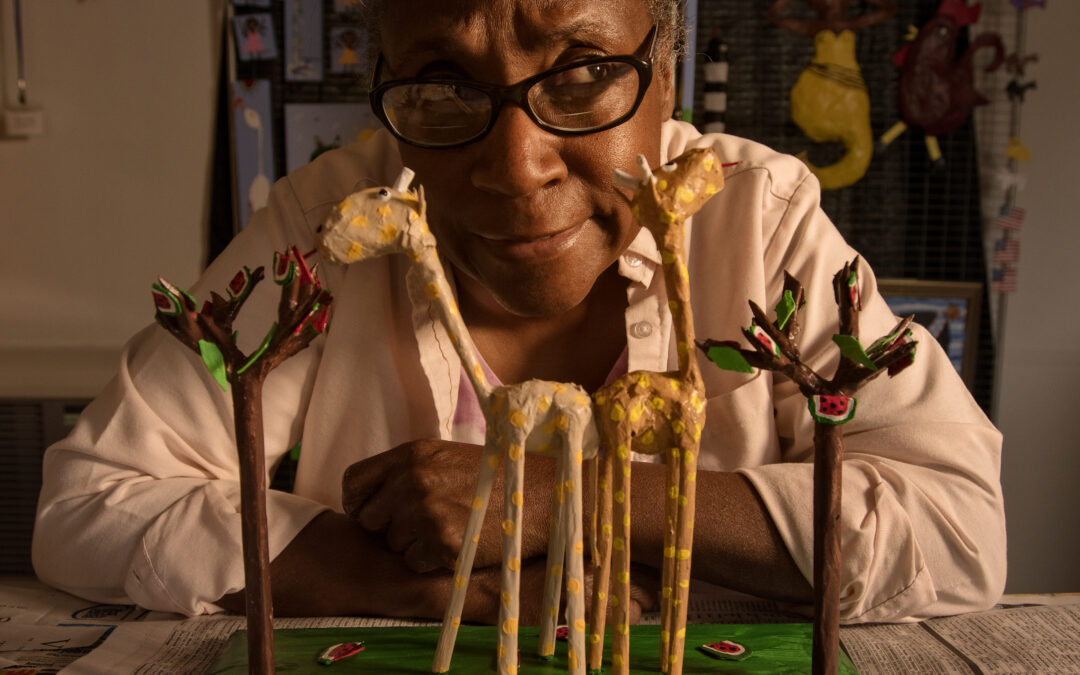(MAMA-Girl, Woman Giraffe. Photo by Mark Atkinson)
By Betsy DiJulio
“Cullen, I think we ought to do a MAMA-Girl show,” said the voice at the other end of the line. It was 2023 and Cullen Strawn, Ph.D., ODU’s executive director for the arts, had picked up the phone to hear the voice of Andrew Fine. Fine and his wife Barbara are longtime champions of the arts, philanthropists, civic leaders, and business owners in coastal Virginia.
The timing was uncanny. When Strawn accepted a position at ODU in 2015, the late professor Ken Daley, mentioned to him in passing that an Eastern Shore artist who went by “MAMA-girl” had visited campus in the past to give workshops. With his curiosity piqued, Strawn recalls doing a little digging, unearthing WHRO’s eight-minute Curate episode, and falling in love with her on the spot. “She reminded me of my mom…she felt like family.” And Strawn was far from the only person who felt a strong personal connection to this legend. In fact, it was MAMA-Girl’s way with people that Strawn considers her “secret sauce.”
But over the eight ensuing and consuming years, MAMA-Girl had been far from Strawn’s mind. Until she wasn’t. He reports that she increasingly became part of his mindscape, though they never met, until he was thinking of her almost daily. It was at that point that Fine’s call came in to which Strawn replied, “Funny you should say that.” The Fines connected him to collectors and those collectors to others, along with MAMA-Girl’s son and daughter. An open call led to more collectors, including the Barrier Islands Center, and soon the exhibition took shape, despite a few bumps along the way, thanks to loans from more than a dozen collectors in Maryland, North Carolina, and Virginia.
Said the Fines in a joint statement, “We became MAMA-Girl ‘groupies’ the first time we met many years ago. Her gentle demeanor and dimpled smile were irresistible. She called herself a ‘prophetessa’ and said God had personally called upon her to make her art and spread his word. This expansive, in-depth retrospective, with its joyous depictions of people and animals, its humor and outreach to all, celebrates the prophetessa’s legacy.” Similarly, collector Becky Bump recalls that she “liked everything about her; her authenticity, her spirit, her commitment. I found her inspiring. The spirit had moved her, and this is what it moved her to do.”
A pastor in the Celebration of Life Community Church, who preached in her trailer in Painter, VA, and a top agricultural crew leader beloved of bosses and workers alike, MAMA-Girl never trained as an artist. When allergies and seizures forced this high school dropout to quit the field work she loved, she found her way to art, though she didn’t consider it art; rather, a spiritual calling. And she and the spirit didn’t always agree. However, Strawn reports that it was when she “invited the spirit in” and obeyed its commands to, for example, put boots on chickens, her work would sell out. Ultimately, she was able to achieve financial freedom through the sale of her affordably priced paintings and sculpture at shows across the country where she connected with a growing group of followers. She was continually surprised that people wanted to buy her work, including internationally.
This retrospective exhibition of 150 artworks and studio objects includes representative examples of many of her favorite themes, what Strawn informally refers to as Bounties of Land and Sea, Family and Community, Animals, Flowers, Last Suppers and Spiritual Subjects, and Black Presidents, pre-Obama. Says Strawn, it is as though she “painted a black president into existence.”
Bright and colorful, playful and whimsical, the work has the distinct look of outsider art, though it is recognizable as MAMA-Girl’s own. And it reflects the same joy and optimism that infused her sermons. For example, in her oeuvre, watermelons—with their juicy red flesh and proliferation of seeds—are not disparaging stereotypes of African American culture. Rather, this woman who spent most of her life working with fruits and vegetables, saw watermelons as symbols of life and renewal.
The sculptural work is all created using Elmer’s glue and newspaper or toothpicks wrapped in paper towels on which she had blotted her paint brushes. For larger structures, MAMA-Girl developed her own method of rolling newspapers to create dowels for armatures, though she used judicious amounts of hot glue to attach pieces together. A vignette of her studio, with a partially completed zebra sculpture, provides a peak into her construction methods and other ways of working.
This reconstruction joins a life size model of her pulpit, built by Josh Knibb and Woody Robinson of ODU’s University Theatre, and other artifacts that, together, treat visitors to a fuller picture of this artist and her vision: handwritten notebook of her sermons; original videos by Mark Atkinson and Jeff Fine, including an unpublished interview; historical photographs of life on the Eastern Shore from Eastern Shore of Virginia Regional Library and Heritage Center; photos courtesy of the Virginia Folklife Program; and stories and photos from collectors of MAMA-Girl’s art. In the spring, the Gordon Galleries will release an illustrated catalogue documenting the exhibition.
This visual equivalent of a “joyful noise” will be on view through May 10 of next year.
WANT TO SEE?
Mama-Girl! (1953-2018)
Through May 10, 2025
The Baron and Ellin Gordon Art Galleries @ ODU




